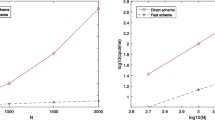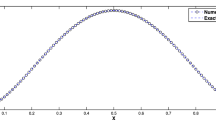Abstract
A discontinuous Galerkin finite element heterogeneous multiscale method is proposed for advection–diffusion problems with highly oscillatory coefficients. The method is based on a coupling of a discontinuous Galerkin discretization for an effective advection–diffusion problem on a macroscopic mesh, whose a priori unknown data are recovered from micro finite element calculations on sampling domains within each macro element. The computational work involved is independent of the high oscillations in the problem at the smallest scale. The stability of our method (depending on both macro and micro mesh sizes) is established for both diffusion dominated and advection dominated regimes without any assumptions about the type of heterogeneities in the data. Fully discrete a priori error bounds are derived for locally periodic data. Numerical experiments confirm the theoretical error estimates.




Similar content being viewed by others
References
Abdulle, A.: Fourth order Chebyshev methods with recurrence relation. SIAM J. Sci. Comput. 23(6), 2041–2054 (2002)
Abdulle, A.: Multiscale methods for advection-diffusion problems. Discrete Contin. Dyn. Syst. suppl., 11–21 (2005)
Abdulle, A.: On a priori error analysis of fully discrete heterogeneous multiscale FEM. Multiscale Model. Simul. 4(2), 447–459 (2005)
Abdulle, A.: Analysis of a heterogeneous multiscale FEM for problems in elasticity. Math. Models Methods Appl. Sci. 16(4), 615–635 (2006)
Abdulle, A.: Multiscale method based on discontinuous Galerkin methods for homogenization problems. C. R. Acad. Sci. Paris, Ser. I 346(1–2), 97–102 (2008).
Abdulle, A.: The finite element heterogeneous multiscale method: a computational strategy for multiscale PDEs. GAKUTO Int. Ser. Math. Sci. Appl. 31, 135–184 (2009)
Abdulle, A.: Discontinuous Galerkin finite element heterogeneous multiscale method for elliptic problems with multiple scales. Math. Comput. 81(278), 687–713 (2012)
Abdulle, A., Bai, Y.: Reduced basis finite element heterogeneous multiscale method for high-order discretizations of elliptic homogenization problems. J. Comput. Phys. 231(21), 7014–7036 (2012)
Abdulle, A., E, W., Vanden-Eijnden, E.: The heterogeneous multiscale method. Acta Numer. 21, 1–87 (2012)
Abdulle, A., Medovikov, A.A.: Second order Chebyshev methods based on orthogonal polynomials. Numer. Math. 90(1), 1–18 (2001)
Abdulle, A., Nonnenmacher, A.: A short and versatile finite element multiscale code for homogenization problems. Comput. Methods Appl. Mech. Eng. 198(37–40), 2839–2859 (2009)
Abdulle, A., Vilmart, G.: Analysis of the finite element heterogeneous multiscale method for quasilinear elliptic homogenization problems. Math. Comput. (2013, in press)
Acerbi, E.: Convergence of second order elliptic operators in complete form. Boll. Unione Mat. Ital. (B) 18(5), 539–555 (1981)
Agmon, S.: Lectures on Elliptic Boundary Value Problems. D. Van Nostrand Co., Princeton (1965)
Allaire, G., Raphael, A.: Homogenization of a convection-diffusion model with reaction in a porous medium. C. R. Math. Acad. Sci. Paris 344(8), 523–528 (2007)
Arnold, D.N.: An interior penalty finite element method with discontinuous elements. SIAM J. Numer. Anal. 19(4), 742–760 (1982)
Arnold, D.N., Brezzi, F., Cockburn, B., Marini, L.D.: Unified analysis of discontinuous Galerkin methods for elliptic problems. SIAM J. Numer. Anal. 39(5), 1749–1779 (2002)
Ayuso, B., Marini, L.D.: Discontinuous Galerkin methods for advection-diffusion-reaction problems. SIAM J. Numer. Anal. 47(2), 1391–1420 (2009)
Bensoussan, A., Lions, J.L., Papanicolaou, G.: Asymptotic analysis for periodic structures, volume 5. North Holland (1978).
Burman, E., Zunino, P.: A domain decomposition method based on weighted interior penalties for advection-diffusion-reaction problems. SIAM J. Numer. Anal. 44(4), 1612–1638 (2006)
Chen, S., E, W., Shu, C.-W.: The heterogeneous multiscale method based on the discontinuous Galerkin method for hyperbolic and parabolic problems. Multiscale Model. Simul. 3(4), 871–894 (2005)
Ciarlet, P.G.: The finite element method for elliptic problems, volume 4. North-Holland (1978).
Ciarlet, P.G., Raviart, P.A.: The combined effect of curved boundaries and numerical integration in isoparametric finite element methods. In: Aziz, A.K. (ed.) Math. Foundation of the FEM with Applications to PDE, pp. 409–474. Academic Press, New York (1972).
Cockburn, B., Dong, B., Guzmán, J., Qian, J.: Optimal convergence of the original DG method on special meshes for variable transport velocity. SIAM J. Numer. Anal. 48(1), 133–146 (2010)
Dawson, C., Sun, S., Wheeler, M.F.: Compatible algorithms for coupled flow and transport. Comput. Methods Appl. Mech. Eng. 193(23–26), 2565–2580 (2004)
De Giorgi, E., Spagnolo, S.: Sulla convergenza degli integrali dell’energia per operatori ellittici del secondo ordine. Boll. Unione Mat. Ital. 4(8), 391–411 (1973)
Du, R., Ming, P.: Heterogeneous multiscale finite element method with novel numerical integration schemes. Commun. Math. Sci. 8(4), 863–885 (2010)
E, W., Engquist, B.: The heterogeneous multiscale methods. Commun. Math. Sci. 1(1), 87–132 (2003)
E, W., Ming, P., Zhang, P.: Analysis of the heterogeneous multiscale method for elliptic homogenization problems. J. Am. Math. Soc. 18(1), 121–156 (2004)
Henning, P., Ohlberger, M.: The heterogeneous multiscale finite element method for advection-diffusion problems with rapidly oscillating coefficients and large expected drift. Netw. Heterog. Media 5(4), 711–744 (2010)
Hill, T.R., Reed, W.H.: Triangular mesh methods for the neutron transport equation. Los Alamos, Report LA-UR-73-479 (1973).
Hou, T.Y., Park, P.J.: Multiscale numerical methods for singularly perturbed convection-diffusion equations. Int. J. Comput. Methods 1(1), 17–65 (2004)
Houston, P., Schwab, C., Süli, E.: Discontinuous hp-finite element methods for advection-diffusion-reaction problems. SIAM J. Numer. Anal. 39(6), 2133–2163 (2002)
Jikov, V.V., Kozlov, S.M., Oleinik, O.A.: Homogenization of differential operators and integral functionals. Springer, Berlin (1994)
Johnson, C., Pitkäranta, J.: An analysis of the discontinuous Galerkin method for a scalar hyperbolic equation. Math. Comput. 46(173), 1–26 (1986)
Marcellini, P.: Convergence of second order linear elliptic operators. Boll. Unione Mat. Ital. (B) 16(5), 278–290 (1979)
Murat, F., Tartar, L.: H-convergence, topics in the mathematical modeling of composite materials. Progr. Nonlinear Differ. Equ. Appl. 31, 21–43 (1997)
Stynes, M.: Steady-state convection-diffusion problems. Acta Numer. 14(82), 445–508 (2005)
Wallstrom, T.C., Hou, S., Christie, M.A., Durlofsky, L.J., Sharp, D.H.: Accurate scale up of two phase flow using renormalization and nonuniform coarsening. Comput. Geosci. 3(1), 69–87 (1999)
Yu, T., Yue, X.: Heterogeneous multiscale discontinuous Galerkin method for convection-diffusion problems (2011, preprint).
Acknowledgments
This work was supported in part by the Swiss National Science Foundation under Grant 200021 134716/1.
Author information
Authors and Affiliations
Corresponding author
Appendix A: The effect of numerical integration for single scale DG-FEM
Appendix A: The effect of numerical integration for single scale DG-FEM
In this section, we study the influence of numerical integration for a single scale discontinuous Galerkin method. Without loss of generality we take the homogenized problem (4) as model problem for a single scale advection–diffusion problem. The single scale analysis presented in this section consists of two parts. First, we briefly comment on the analysis of the single scale DG-FEM without numerical quadrature used here for advection–diffusion problems, as it slightly differs from the method analyzed in [18] due to the choice of a different model problem. Second, we derive the stability and a priori results for the single scale DG-FEM with numerical quadrature defined in (49).
1.1 A.1 DG-FEM without numerical quadrature
For \(v^H, w^H \in V^1(\Omega ,\mathcal{T }_H)\), let us introduce the bilinear form \(B_0 = B_{D,0} + B_{A,0}\) by
with the penalty weighting function \(\mu _S\) on an edge \(e \in \mathcal{E }\) given by \(\mu _S|_e = \alpha {\Vert {\{a^0(s)\}}\Vert }_\mathcal{F }H_e^{-1}\), where the penalization parameter \(\alpha > 1\) is a positive parameter independent of the local mesh size and the data \(a^0\), and the index \(i_0(s)\) is discussed in Remark 3.2. We define \(u^{0,H}\) as the solution of the variational problem: find \(u^{0,H} \in V^1(\Omega ,\mathcal{T }_H)\) such that
Compared to the bilinear form \(\tilde{B}_0\), defined in (48), the integrals are evaluated exactly in \(B_0\), i.e., no numerical quadrature is used. Thus, the method given by (59) is free of any non-consistent perturbations and the Galerkin orthogonality holds
The stability of the method can be shown following the proof of Theorem 4.3 by setting \(r_{vc,A} = 0\) (cf. Remark 5.10). Moreover, the a priori error estimate can be derived analogously to [18, Theorem 5.1], i.e., if \(u^0 \in H^2(\Omega )\) then
1.2 A.2 DG-FEM with numerical quadrature
In this section, we study the single scale DG-FEM based on the bilinear form \(\tilde{B}_0\) given by (48).
Stability. The proof of the inf–sup condition for \(\tilde{B}_0\) follows the proof of Theorem 4.3 by replacing \(a^0_K\) and \(b^0_K\) by \(a^0(x_K)\) and \(b^0(x_K)\), respectively, leading to
This yields the same conditions A, B, C and D as in the proof of Theorem 4.3 with \(r_{vc,A}\) replaced by \({\tilde{r}}_{vc,A}\).
A priori error estimate. Having shown the inf–sup condition for \(\tilde{B}_0\) we derive the a priori error estimate for the single scale DG-FEM based on numerical integration used as estimate for the macro error \(e_{mac}\).
Theorem A.1
Let \(u^0 \in H^2(\Omega )\), \(a^0 \in (W^{1,\infty }(\Omega ))^{d \times d}\) and \(b^0 \in (W^{2,\infty }(\Omega ))^d\). Then the solution \(\tilde{u}^{0,H}\) of the variational problem (49) satisfies the estimate
where \(C\) is independent of \(H\).
Proof
We combine the ideas of the proof of Theorem 4.6 and [18, Theorem 5.1]. We decompose the total error into two parts \({|||{u^0 - \tilde{u}^{0,H}}|||} \le {|||{u^0 - P_H u^0}|||} + {|||{P_H u^0 - \tilde{u}^{0,H}}|||}\) using the \(L^2\) projection \(P_H u^0\). Then, using the inf–sup condition for \(\tilde{B}_0\), with stability constant \(\tilde{\alpha }_S\), and the consistency (60) leads to
Thus, we get the error decomposition
where the first two terms are identical to the error terms arising in the proof of (61) and the third term quantifies the effect of the numerical integration. Due to the decompositions \(B_0 = B_{D,0} + B_{A,0}\) and \(\tilde{B}_0 = \tilde{B}_{D,0} + \tilde{B}_{A,0}\) given by (58) and (48), respectively, we first estimate the difference \(\tilde{B}_{D,0}(P_H u^0,w^H) - B_{D,0}(P_H u^0,w^H)\). Following the ideas of Lemma 5.12 we have
Next, we need to estimate \(\tilde{B}_{A,0}(P_H u^0,w^H) - B_{A,0}(P_H u^0,w^H)\). Following Lemma 5.7 we obtain
where we used \({|{P_H u^0}|}_{*,D} = {|{P_H u^0 - u^0}|}_{*,D}\), as \(H^2(\Omega ) \hookrightarrow C^0(\Omega )\) for \(d \le 3\) and \(u^0 = 0\) on \(\partial \Omega \). If \(b^0\) has the additional regularity \(b^0 \in (W^{2,\infty }(\Omega ))^d\), we can improve estimate (63) using [23, Theorem 4]
Finally, combining estimates (62), (63), (64) and (65) allows to estimate the effect of the quadrature
\(\square \)
Rights and permissions
About this article
Cite this article
Abdulle, A., Huber, M.E. Discontinuous Galerkin finite element heterogeneous multiscale method for advection–diffusion problems with multiple scales. Numer. Math. 126, 589–633 (2014). https://doi.org/10.1007/s00211-013-0578-9
Received:
Revised:
Published:
Issue Date:
DOI: https://doi.org/10.1007/s00211-013-0578-9




